#public mental health
Text
9/11 and Batman
Originally a Twitter thread from 2018. With edits and updates.
Batman, Wanda & Pietro Maximoff, 9/11 and mass casualty events, or how we and our government participate in mutual gaslighting, and some thoughts on breaking the cycle for the benefit of our politics.
Continue reading 9/11 and Batman
5 notes
·
View notes
Text
How The Buildings You Occupy Might Be Affecting Your Brain
— By Cleo Valentine & Heather Mitcheltree + BIO
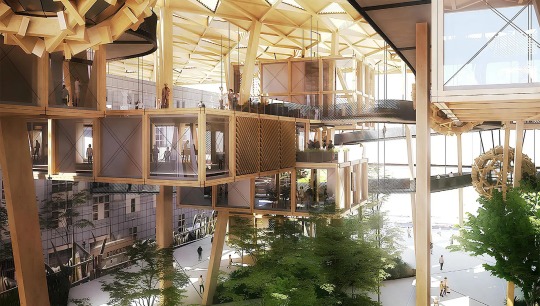
Cutting-edge research in the field of neuroarchitecture is revealing the public health implications of building design
Have you ever experienced a space that made you feel uneasy or stressed? Perhaps it was a noisy and crowded shopping mall, with its neon signs, patterned tilework and boldly painted walls in franchise signature colours. Or the poorly lit work carpark with flickering fluorescent lighting, low ceilings and hard concrete surfaces that made your every footstep echo. Now contrast that experience with a space that made you feel at ease. It might have been that time you were sitting at the table in your friend’s kitchen – the sun coming in through the window, warming your skin and filling the space with light; the smell of fresh coffee brewing; and the first blush of colour in the buds of the pot plants on the windowsill. Or maybe it was sitting in your favourite spot at the local library – the comfy seat in the quiet area with the high ceilings, ample natural light and a view out over the courtyard garden.
Many of us have felt the effects of being in different built environments. Yet what this means for our health and wellbeing hasn’t received enough research attention. How do the offices, houses, hospitals, schools, neighbourhoods and spaces that we occupy day to day affect our health? Traditionally, our understanding of how architectural design affects the human body has centred around the transmission of communicable diseases, such as viruses. For instance, the postwar urban redesign of the UK’s tenements worked to address overcrowded, damp and poorly ventilated housing conditions that are associated with increased rates of infectious diseases such as tuberculosis. However, the health effects of the built environment may be significantly more far-reaching than this.
Enter the emerging field of neuroarchitecture – an interdisciplinary domain that explores how the built environment affects human brain function, behaviour, cognition and psychology. Initial research indicates that, beyond its influence on infectious diseases, architectural design and form might also actively contribute to increased levels of stress in the body, which in turn could increase the risk of so-called noncommunicable diseases (often referred to as ‘lifestyle diseases’), including neurodegenerative and psychiatric conditions such as Alzheimer’s, Parkinson’s disease, depression and anxiety.
A better understanding of how the built environment impacts our health in these ways could revolutionise building design and urban planning. Imagine being able to design spaces that not only don’t cause harm, but actually promote overall wellbeing. In many ways, this burgeoning field validates what many of us have long intuitively felt: architecture is not merely the backdrop to our lives, but a crucial determinant of how we live and thrive.
That converted loft apartment in the real estate magazine might actually be a home that could reduce your bodily stress
Rapid urbanisation lends an urgency to this research. The United Nations estimates that, by 2050, two-thirds of the global population will live in cities. In developed countries, people already spend most of their time indoors. Some vulnerable groups in Europe, such as the elderly, infants, young children and people with weakened immune systems, spend almost all of their time indoors. These numbers are likely to grow due to the extreme and increasingly unpredictable weather patterns caused by climate change.
Meanwhile, studies in neuroarchitecture reveal the impact of even small changes in architectural and urban design. For example, rooms with lower ceilings and smaller windows can increase stress responses in the body. Yes, that converted loft apartment with high ceilings, large windows, lots of natural light and timber floors in the real estate magazine might actually be a home environment that could help reduce your bodily stress.
Similarly, some high-contrast visual patterns in architecture, such as striped facades, acoustic panels and patterned carpets can cause visual discomfort, and in extreme instances can lead to migraines and seizures in vulnerable individuals. For instance, many hotels and cinemas use carpets with complex, high-contrast patterns in their hallways and lobbies to hide stains and wear and, in the case of facilities such as casinos, in a deliberate attempt to cause disorientation and impair decision-making processes. Additionally, the use of slatwall has become increasingly common in contemporary architecture. Once you notice this slatted wall panelling, you see it everywhere. Yet these structures, often arranged in repetitive, high-contrast patterns, can be visually overwhelming.
At the other end of the spectrum, visually monotonous environments can have a negative effect on people. Such spaces are characterised by minimal variation in the placement of windows and doors, and a lack of distinguishing features or details – a highly minimalist or functional aesthetic that is prevalent in some contemporary architecture. For example, think about the interchangeable architectural landscapes found in many commercial districts across the United States and Canada. In many instances, it is difficult to tell one city from the next. This is particularly the case in newbuild tract housing neighbourhoods, or shopping malls and retail centres. These environments tend to elevate stress levels because they fail to engage our senses. In contrast, settings with varied design elements and distinctive features, such as a streetscape with collections of smaller stores and restaurants, like Camden Passage in London, provide mental stimulation and a sense of interest, which can help reduce stress and promote wellbeing.
We spend a lot of time in places with spatial stressors and this could gradually affect our mental health
Understanding the full impact of long-term exposure to stress-inducing architectural designs on human health is a work in progress. New insights are emerging from neuroimmunology: the study of the interaction between the immune system and the nervous system. This shows that one particularly concerning consequence of chronic stress is inflammation of the brain. Neuroinflammation is implicated in several neurodegenerative and psychiatric disorders, including depression, Alzheimer’s and schizophrenia. What’s more, neuroinflammatory conditions appear more prevalent in urban areas, potentially due to factors such as pollution, reduced social cohesion, and increased stress associated with urban living. However, the established links between architecture and stress, and between stress and neuroinflammation, raise an overlooked question: Could bad architecture also be contributing to the development of neurodegenerative and psychiatric disorders?
You might think that being in stressful architectural environments isn’t that big a deal. But bear in mind research has shown that certain building features, such as room size, wall shapes and window layouts, can cause stress without us realising it. Moreover, we often spend a lot of time in places with spatial stressors – in offices, homes and schools – and this ongoing exposure could gradually affect our mental and neurophysiological health.
To explore this further, our team at the University of Cambridge is researching the impact of architecture on neuroinflammation. Most recently, we conducted a pilot study to examine how buildings with different architectural features affected markers of brain inflammation linked to stress. Specifically, we looked at something called biophilic design – the incorporation of natural elements into architecture, such as plants and natural light.
Participants looked at images of two different high-rise buildings for nine minutes each. The first building – depicted in photorealistic images – is a proposed development in Montreal, Canada that showcased a moderate degree of biophilia with its fractalised design patterns (these are patterns that repeat at different scales, as occurs in nature), organic building materials such as timber, a visually complex and interesting design, and vegetation incorporated on balconies and elsewhere. The second building, built in 2011 and located in The Hague in the Netherlands, was less biophilic because it lacked fractalised patterns, vegetation and organic building materials, though it was similar in terms of its height, colour and level of design detail.

The Farmhouse Cacade. Image Courtesy ©Studio Pecht

The Farmhouse Interior. Image Courtesy ©Studio Pecht
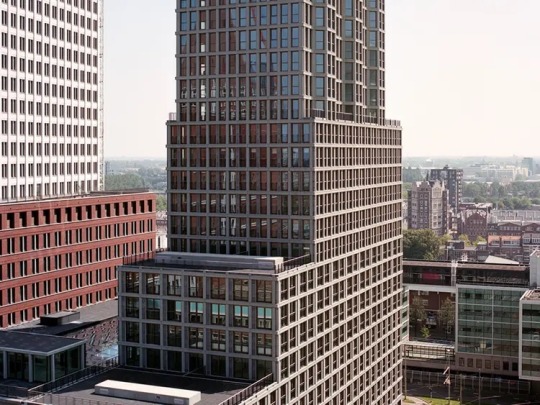
De Kroon Office and Residential Buildings Exterior. Courtesy Rapp+Rapp/Photo by Kim Zwarts

De Kroon Office and Residential Buildings Interior. Courtesy Rapp+Rapp/Photo by Kim Zwarts
At the same time as the participants looked at these two building types, we measured their electrical brain activity using electroencephalography (EEG), a non-invasive method that involves wearing a head cap with electrodes. We used an innovative technique to infer signs of acute brain inflammation by comparing our participants’ brain activity with historical data showing associations between blood markers of inflammation and EEG recordings.
We found that participants exhibited lower levels of brain inflammation when exposed to the building with higher biophilia. This provides tentative evidence that integrating more biophilic or natural elements into architectural designs may help reduce brain inflammation, and expands on our current understanding of their stress-reducing benefits. This makes sense from an evolutionary perspective: humans evolved in natural environments, so we are drawn to the kind of natural environments in which our ancestors lived and we are healthier and less stressed in them. If further research supports our findings, it suggests that increasing natural light, integrating green spaces and designing spaces that encourage social interaction may help mitigate the negative impacts of urban living on neurological health.
What might this mean for everyday spaces? Consider schools – while it’s easy to recognise tangible risks such as overcrowding, dampness, poorly ventilated classrooms or hazardous materials such as asbestos, we often overlook the less visible impacts on neurophysiological health. For instance, how does visual stress from poor natural lighting and fluorescent light flicker affect students, especially those with neurodivergence or ADHD? What might be the long-term effects of low-ceilinged classrooms that lack natural light and other biophilic features? These are crucial questions that remain unanswered but are essential to ensure the health, wellbeing and best long-term learning outcomes for our children. Similar concerns apply to hospitals, workplaces and numerous other spaces.
The emerging research linking architectural design to neurological wellbeing marks a pivotal shift in our understanding of public health. We design our world and, in turn, it shapes us. The built environments we interact with daily are not passive elements but active factors that can inhibit or – with thoughtful consideration – enhance our neurological state and holistic wellbeing.
1 note
·
View note
Text
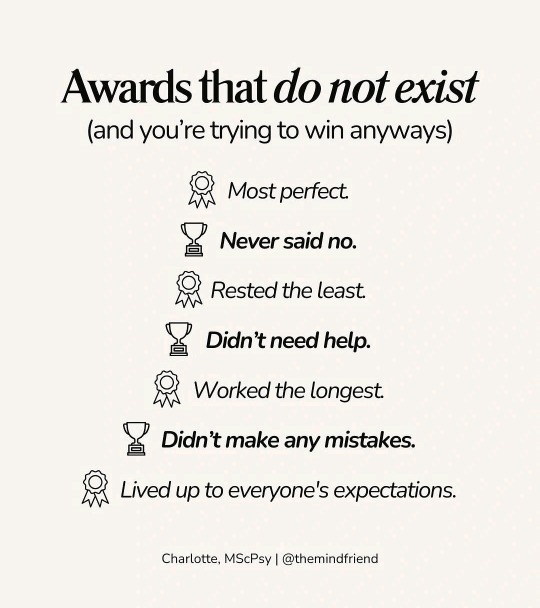
#medicine#medical#public health#infographic#mental health#autism#mentalhealth#psychotherapy#self love#awards
995 notes
·
View notes
Text
“how would it work if Cybertronians had disabilities” “What if there were disabled Cybertronians”
THERE ARE
THERE ARE
loosing my mind at how some things that are So good can be So niche why can’t we just be a hivemind
Just one example, my favorite example, is:

Shattered Glass Soundwave!!!

He’s gone through Multiple reformats varying between with his consent and,,, not. The latest of which took place when they didn’t have many materials
So they used half earth metals half Cybertronian ones
As it turns out? Those two things don’t mix very well. His joints are Horrible. They lock up randomly, the worst of which being the door to his tape deck.
He physically isn’t able to dock his cassettes reliably because they might get stuck in there.
What does he do to fix this? So glad you asked!! He has his own assistive aids, in this case: a portable external carrying case
It was made and personalized to work specifically for him and his situation
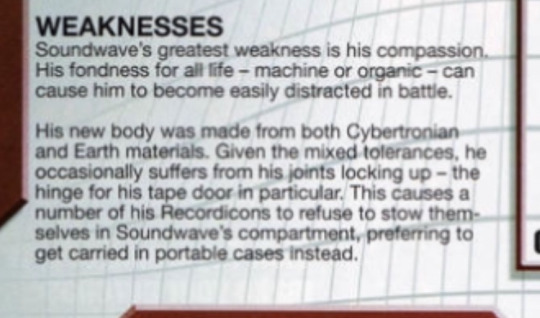
I love him
#SG soundwave#transformers#tf shattered glass#maccadam#soundwave#fun publications#Cybertronian.. biology? biology#cybertronian biology#been wanting to make this posts for Months but took ages trying to find the damn chracter sheet that actually delved into the details#I can’t have people disregarding my boy like this#obviously there’s a Wide variety of ways we all know mental health and disabilities can translate into transformers#but everyone acts like the PHYSICAL disabilities are something that don’t exist canonically#that we have to either invent ways for the rep to exist or that the rep shouldn’t exist at all#soundwave ISNT the only one either! he’s just my favorite!#Cybertronian disability
3K notes
·
View notes
Text
When Jesus pretended to be dead for 3 days it's a miracle and everyone is sympathetic. But when I, James Somerton-
#james somerton#hbomberguy#Sorry#just to be clear i dont wish somerton any harm#for the money he tricked people into donating i'm sure there will be a lawsuit. maybe??#for the plagiarism idk if and how the law applies#for his personal mysoginistic racist etc views i've seen maybe one of his videos years ago and i don't remember his claims#i just think that as an influancer / youtuber he's a public figure and it's not the public's responsability to cater to his mental health#whether his mental health issues are real or just excuses#i'd rather he change career and be held accountable than he hurting himself#being in a bad mental state doesn't justify your actions#especially if the bad mental state is directly caused by the conequences of said actions
453 notes
·
View notes
Text

CO-OP! PISSING! THREE! RANCHERS EDITION!!!
commission for @shepscapades :)
#what a way to wake up my mcyt followers lmao#solidaritygaming#jimmy solidarity#tango tek#tangotek#trafficblr#traffic smp#mcyt#art#fanart#commission#using the life server public restrooms is a fucking mental health hazard
1K notes
·
View notes
Text
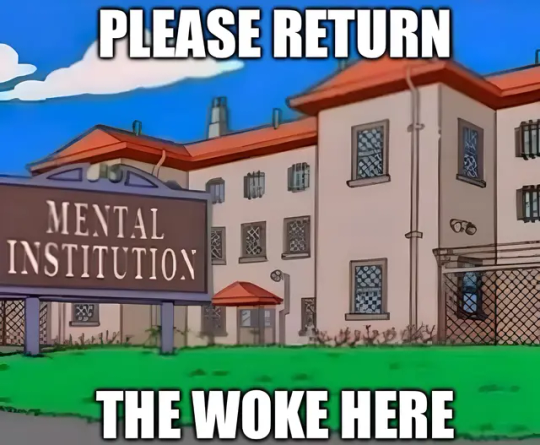
Keep the woke democrats safe.
#wef#nwo#election fraud#joe biden#woke#mental health#indoctrination#public school#home school#trump 2024
396 notes
·
View notes
Note
Forget the IF, just wanted to check in and see if YOU were okay dear author? I hope everything is well. I know you have a process lol, but I miss seeing you on my TL from time to time.
oh, kjsdhfjskdf . how sweet<3 thank you for this! I am doing well, crafting ouro alongside some personal shifts and growth and setbacks and victories. it has been a godsend to take all this pressure off for this period and do things my way. though, I'll say: while it has taken and will probably take another while, this silence will be broken at some point. I'll avoid saying soon only because I'm staunchly sticking to my pace&process.
however !! I finished the draft for the first book yesterday. !! I am currently doing some hefty edits, collecting art and testing coding (&learning something new a hundred times over, over, again, whether it be storycrafting, interactivity, ui design, social media, art, code ... the list goes on) and so for the most part, I'm having a good time, as long as we count the entire spectrum of the human condition as a mostly good time. pfft.
I miss hanging out here too! I genuinely can't wait to get back to online shenanigans once I feel ready for it; if you'll have me, of course. I can imagine that this type of secret development is frustrating and everyone has their limit.
It means a lot that you sent this my way. Hope you're doing well too. <3
#OUROBOROS#ouroboros-if#interactive fiction#so much has changed that i see the public demo as an entirely different work at this point. It has been a fun but daunting journey and some#part of me is sad that I couldn't handle sharing that process as much as I'd like. but life takes precedent and that's just how it be#im so pleasantly surprised that the majority of people who advocate for mental health first actually follow through on the compassion#they promise. do you know what I mean? ouro & the community around it is tiny in the grand scheme but#I have never felt so supported in my entire life#every time I feel scared or hopeless the people around me (and you know who you are. I love you!!) have given me nothing but grace#and the joy of their friendship. that's enough for me-- for now >:3
150 notes
·
View notes
Text
Cruelty from Fear, Selfishness from Anxiety
A rescued thread from Twitter, originally posted in March, 2022
An interesting observation from a session today: Cruelty evolves from fear, because if one cannot name a fear, all unknowns become a threat. And selfishness evolves from anxiety, because anxiety’s universalized unnamed fears limit the ability to use theory of mind skills. *
Continue reading Cruelty from Fear, Selfishness…
View On WordPress
7 notes
·
View notes
Text
reading supercut: disability, body image, and trauma
A glimpse into the clothes thrashing around in the washing machine of my mind, with apologies that it is still a wet lump and not an actual synthesis of ideas.
From Easy Beauty: A Memoir by Chloé Cooper Jones:
[This event] embedded a damaging idea in me, one I’d recognize deeply when I read Scarry years later: beauty was a matter of particulars aligning correctly. My body put me in a bracketed, undercredited sense of beauty. But if I could get the particulars lined up just right, I could be re-seen, discovered like the palm tree is discovered. To be deserving of the whole range of human desires, I had to be extraordinary in all other aspects.
In this new light, I started to see my work, my intellect, my skills, my moments of humor or goodness, not as valuable in themselves, but as ways of easing the impact of my ugliness. If only I could pile up enough good qualities, they could obscure my unacceptable body. [...] accepting the argument that beauty was malleable came, for me, with a cost. The Platonian view rejected me cleanly, but Hume and Scarry left a door ajar and I’ve spent a lifetime trying to contort my form to see if I could pass through it.
From Til We Have Faces: A Myth Retold by CS Lewis:
I now determined that I would go always veiled. I have kept this rule, within doors and without, ever since. It is a sort of treaty made with my ugliness. There had been a time in childhood when I didn't yet know I was ugly. Then there was a time (for in this book I must hide none of my shames or follies) when I believed, as girls do — and as Batta was always telling me — that I could make it more tolerable by this or that done to my clothes or my hair. Now, I chose to be veiled.
From Cognitive-Behavioral Therapy of Borderline Personality Disorder by Marsha Linehan:
Inhibited grieving is understandable among borderline patients. People can only stay with a very painful process or experience if they are confident that it will end some day, some time—that they can "work through it," so to speak. It is not uncommon to hear borderline patients say they feel that if they ever do cry, they will never stop Indeed, that is their common experience—the experience of not being able to control or modulate their own emotional experiences. [...] In the face of such helplessness and lack of control, inhibition and avoidance of cues associated with grieving are not only understandable, bur perhaps wise at times. Inhibition, however, has its costs. [...]
Volkan (1983) describes an interesting phenomenon, "established pathological mourning", which is similar to the pattern I am describing. In established pathological mourning, the individual wishes to complete mourning, but at the same time persistently attempts to undo the reality of the loss.
From How to Respond to Criticism by Danny Lavery:
Apologize, but don’t really mean it, and plant a seed of secret resentment so deep in your own heart that years later you can’t even remember that you’re the one who nurtured it and made it grow, it seems that much like a native part of you.
From Tiny Beautiful Things by Cheryl Strayed:
[After learning that state child protective services had made a budgetary decision to only intervene with children under 12, to one of the teenagers that regularly shared stories of abuse at home]
I told her it was not okay, that it was unacceptable, that it was illegal and that I would call and report this latest, horrible thing. But I did not tell her it would stop. I did not promise that anyone would intervene. I told her it would likely go on and she’d have to survive it. That she’d have to find a way within herself to not only escape the shit, but to transcend it [...] I told her that escaping the shit would be hard, but that if she wanted to not make her mother’s life her destiny, she had to be the one to make it happen. She had to do more than hold on. She had to reach. She had to want it more than she’d ever wanted anything. She had to grab like a drowning girl for every good thing that came her way and she had to swim like fuck away from every bad thing. She had to count the years and let them roll by, to grow up and then run as far as she could in the direction of her best and happiest dreams across the bridge that was built by her own desire to heal.
From Essays in Aesthetics by Jean-Paul Sartre:
Freedom is what you do with what's been done to you.
From "I Know What You Think of Me" by Tim Kreider:
if we want the rewards of being loved we have to submit to the mortifying ordeal of being known.
#mental health tw#trauma tw#child abuse tw#child neglect tw#staranise original#kinda#there's also a lot I've been reading about avoidant personality disorder that DEFINITELY needs a lot more baking#before it's ready to be unleashed onto the public
163 notes
·
View notes
Text
hi. it's 1 am here but i just had a Thought while rereading some old speculation and i wanted to write it down before i forget: you know how part of the horror of eddie's breakdown/dissociative episode at the end of the homewarming broadcast is eddie realizing for the first time that On Some Level, he is an object? something that cannot move or act on its own, created to be at the mercy of something much larger than him, etc etc. and y'know how the live action bits of that scene are Very similar, visually speaking, to the bug videos, which are all shot from wally's pov, with the unspoken implication being that this is just kind of how wally Exists, if not 24/7 then at least a significant amount of the time?
hear me out: what if wally just, like. doesn't think his neighbors are Real, in the same vein that he conceives of himself as a puppet rather than a person? yknow. they're fun to play with, and he's learned a lot from them, but the "friends" bit... i mean. you can't really make friends with cheap simulacrums of humanity being maneuvered around by the ones who are Actually real. friendship is more of an actor’s role to him than anything else.
what if that's why he's so attached to home; because home is so unlike any other living being in the town that they can Only be explained by being Real on some level, as far as wally is concerned? and most importantly: what's wally going to do when he realizes that his neighbors are, in fact, real? when he realizes that being a puppet and being a person are not mutually exclusive? what does that Do to a man's conscience after he's been diving head first into a series of sunk-cost fallacy interdimensional power plays with no regard for how it would affect them? (bc who worries about how their relationships would affect, like. idk their alexa.) how long would it even take him to accept this reality? how long would it take him to realize that this realness also applies to him?
i realize this is kind of a rehash of an OLD post of mine, but the key difference i'm trying to emphasize here is: that old post assumes that wally thinks of himself as a puppet and everyone else as people, but what i am suggesting Here is what if wally does not see any of home's residents as people, and that so happens to Include himself. the distinction is important, at least to me.
anyways. goodnight.
#public notice#wh speculation#wally darling#they weren't lying that unreality/derealization content warning and explorations of mental health can apply
74 notes
·
View notes
Text
Check to see if you have a 'bring your hair dryer to work with you' therapist.
I'm serious. I've been in and out of the mental healthcare system in the UK and US for over 20 years and if I have learned anything about clinicians it is that they divide care into "want to make the client "sane"" and "make the client able to live a comfortable/happy life" categories.
Let me explain.
There's a really good post that can be found here: http://benedante.blogspot.com/2016/12/the-hair-dryer-incident.html
The long and short is a person was struggling with obsessive compulsive disorder who worried that if they left their hair dryer plugged in then they would burn down their house. This had them disrupt their life to check on their fear and their clinician told them to bring the hair dryer to work with them so when the panic set in they could see the hair dryer was with them and it would soothe their fear with minimal disruption.
The blog post above goes into it. Mental healthcare professionals arguing over whether this was "enabling" and a detriment to healing and coping versus those who saw that the life disruption had been solved and it's okay for the client to not be healed if they can live their life.
-
So. Get a 'take your hair dryer to work' therapist. Ask yours about the hypothetical and see where their priorities lie. Are they trying to help you or heal you? They may sound like the same thing but they're not always. Ask yourself what you want from your circumstances?
We have DID and our therapist always treats us as individuals (something the DSM-V specifically warns clinicians against) because she saw how much damage it was doing for us to try and shift and change our behavior to be socially accepteable. It's better for our mental health to embrace "being insane" (my words, not hers) than to repress ourselves to the point of denying anyone the chance to get to know us.
Every clinician will carry baggage with them. That's just normal. But you got to know where their priorities lie. There's a lot of stigma in the mental health field. Knowing if they'd encourage you to act a little crazy for the sake of your peace and comfort helps.
At least. That's our opinion.
#watch me post my trauma in public#ocd#bpd#cptsd#did#therapy#therapists#mental health#camden posting#albeit me and Wynn are blended as fuck today
131 notes
·
View notes
Text
Don't take it out on others
A PSA addressing behavior that's often excused due to mental health.
We all have our issues, our bad days and bad periods, we have our problems and our frustrations, but despite all these thorns in our sides, it's never, ever okay to take it out on someone through passive aggressive behavior, name calling or any other rude approaches.
In these situations one has to address themselves, step back and breathe, find something to stimulate that part of yourself that's not doing well. Get some fresh air by opening a window to breathe, get a glass of water, lie on the floor for a hot minute and just relax. take a break, and ask someone if they can help you.
If you don't have someone you want to rely on or you're someone that doesn't want to bother anyone, write it down. Get it out somehow. but don't ever, ever think that it's okay to take it out on someone else, because it's not.
105 notes
·
View notes
Text
okay, I'm crowdsourcing advice for a minute, so bear with me and please lend some words if you have any:
I want to get out of the house more. Like, on a regular basis. Weekly, maybe. Preferably, I would like to be interacting with people—the same people—every time, for... like... accountability, but also because I am hoping to put myself out there as the 21st century's most neurotic platonic Casanova. Uh. Making a friend or more out of this would be desirable. But I think if I go out with the intention of making a friend, I will be disappointed.
So. I want to go do something, for that something's own sake. I don't want to go be fake once a week hoping to get a friend out of it.
However, the beautiful state of Iowa is a bit cultureless, and I am too introverted and easily overwhelmed for this world (e.g. going to bars is probably not gonna be my thing). So.... I guess.... any suggestions? opinions? thoughts on making friends in general, or finding good activities as an introverted adult, in general?
oh yeah, also: I am poor. that's a factor. so. signing up a class or similar is not a great option right now.
what the heck, I'll add a silly poll for fun:
#Robin processes emotions on main#Robin speaks#I'm mostly talking out loud here. you know how it is#the question itself is too complicated for an easy answer#and everything will change in January when I become unemployed again and start searching for an in-person job anyway#but hey..... (trails off with nothing to say)#to clarify: right now I'm working part time online#and I'm surviving but my mental health is kind of..... tenuous. I'm lonely. I've got no regular in person contact with non-family#also the young-adults group thing sounds uniquely agonizing. I'm restructuring my entire way of faith right now#and so my choices in a young adults group would be.... either fake it or make myself into an embarrassing... like... Thing#impediment to fun and progress or whatever#I don't want to do that. especially if I'm looking to make friends. it'd be like therapy but public and with strangers and frankly#probably very very midwestern-bland-white-evangelical and I don't know if I can take it... I don't know if I can do it#yeagh#OH. ALSO. BY THE WAY. when I say ''a friend or more'' I do NOT mean a friend or romance alsjdflsjdlkdfjsjla#I mean ONE OR MORE friends.
45 notes
·
View notes
Text
You don't understand! This is my
Emotional Support Escapism Fantasy
I guess call it "maladaptive day dreaming" if you must
#shitpost#shitposting#neurodivergent#neurodivergent memes#maladaptive daydreaming#mental health memes#mental illness memes#the description of maladaptive daydreaming#is just me as an autistic child trying to survive public school#and tbh i don't think it was truly that maladaptive given all my options#but now i can exit the daydream but it will piss me off and makes it difficult to think about other stuff#until I've at least finished the arc i was in the middle of#in case anybody is about to accuse me of misusing the phrase maladaptive day dreaming
161 notes
·
View notes
Text
i feel like this must be a consquence of dts-ification but i swear to god no other sport's fans are mortally offended by the concept of a team firing an athlete for underperforming like f1 fans are
#surely it is possible to acknowledge the impact that public performance struggles & getting booted must have on a driver's mental health#AND get that it is understandable if there are sacking rumours about a driver who only has a 50% podium rate in a championship winning car
196 notes
·
View notes